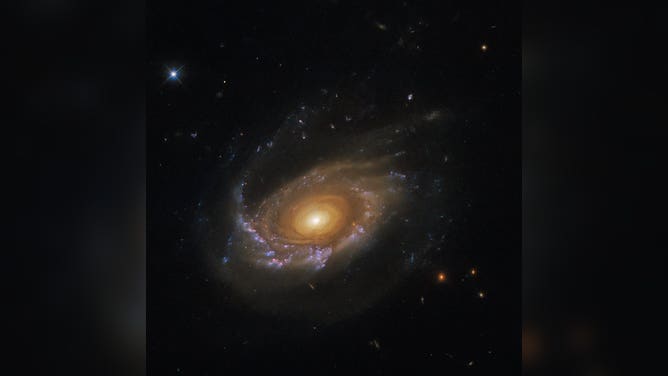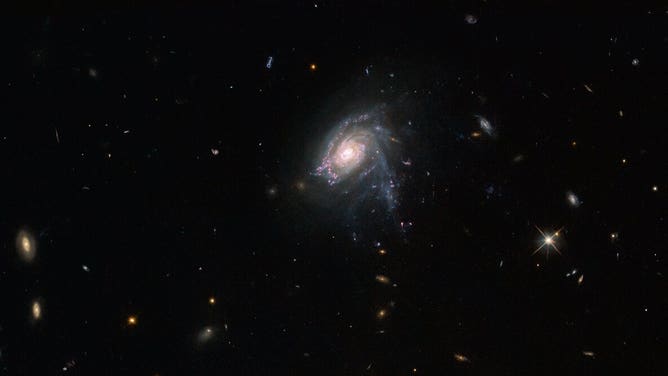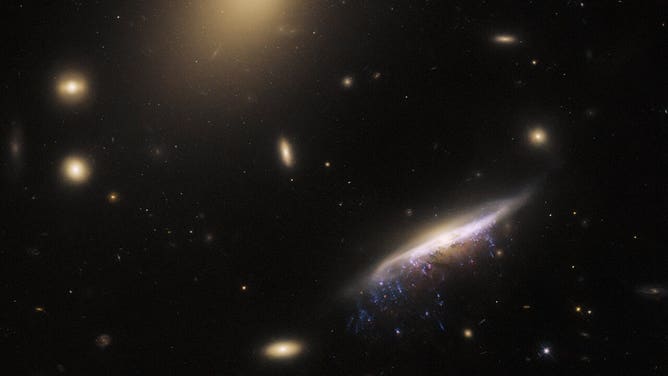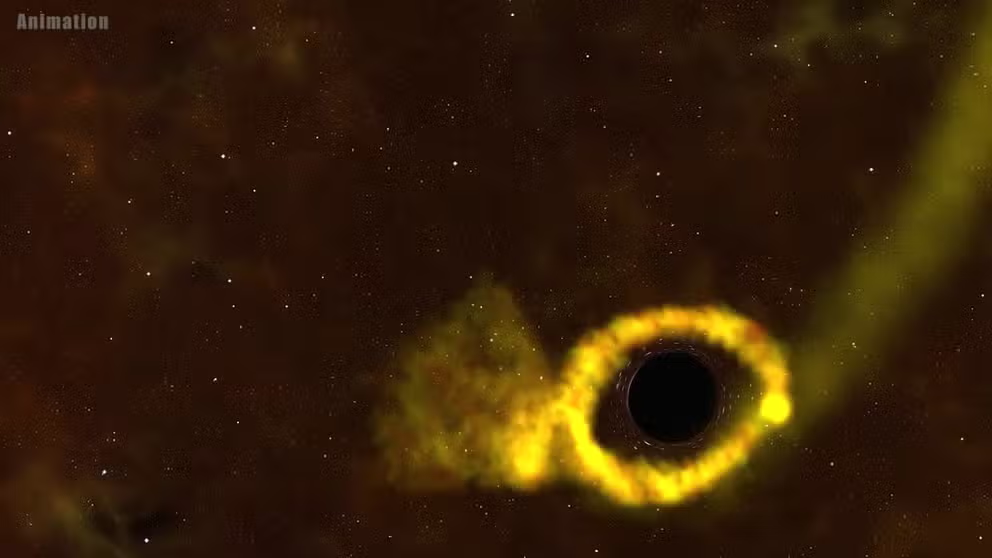‘Jellyfish’ galaxy spotted in new Hubble Space Telescope imagery
This image is the sixth and final installment in a series of observations of jellyfish galaxies made by the Hubble Space Telescope.
Hubble Space Telescope used to watch black hole eat a star
Astronomers used Hubble Space Telescope's ultraviolet capabilities to investigate the death of a recently devoured star nearly 300 million light-years away. These events are known as "tidal disruptions."
NASA released an image Friday of the jellyfish galaxy JO206, captured by the NASA/ESA Hubble Space Telescope. Located in the constellation Aquarius, JO206 is more than 700 million light-years from Earth.
JO206 and other galaxies are referred to as jellyfish because they resemble their aquatic namesakes, according to NASA.

The jellyfish galaxy JO206.
(ESA/Hubble & NASA, M. Gullieuszik and the GASP team / NASA)
This jellyfish-like shape occurs when galaxies move through galaxy clusters. In doing so, NASA said they ram into superheated plasma that pervades the galaxy clusters. As they move through, the jellyfish galaxies strip gas from other galaxies, leaving behind long tendrils of star formation.
In the recently released image taken by Hubble, JO206 can be seen as a bright disk of lavender and pink with long tendrils of bright star formation trailing behind it.
HOW THE TELESCOPE BECAME OUR PORTAL INTO THE UNIVERSE
This image is the sixth and final installment in a "Pictures of the Week" series. According to the European Space Agency, the series includes Hubble observations of jellyfish galaxies.
One of those galaxies was JW39, which lies over 900 million light-years away in the constellation Coma Berenices.

The jellyfish galaxy JW39 hangs serenely in this image from the NASA/ESA Hubble Space Telescope.
(ESA/Hubble & NASA, M. Gullieuszik and the GASP team / NASA)
Another jellyfish galaxy was JO175, which lies over 650 million light-years from Earth in the constellation Telescopium.

The jellyfish galaxy JO175 appears to hang suspended in this image from the NASA/ESA Hubble Space Telescope.
(ESA/Hubble & NASA, M. Gullieuszik and the GASP team / NASA)
Not to be outdone, JO204 was also imaged by Hubble. The jellyfish galaxy lies almost 600 million light-years away in the constellation Sextans, according to NASA and ESA.

JO204, a ‘jellyfish galaxy’ so named for the bright tendrils of gas that appear in this image to be drifting lazily below JO204’s bright central bulk.
(ESA/Hubble & NASA, M. Gullieuszik and the GASP team / NASA)
JW100 was also part of the Pictures of the Week series. It is located in the constellation Pegasus, over 800 million light-years away, according to the ESA.

The galaxy JW100 features prominently in this image from the NASA/ESA Hubble Space Telescope, with streams of star-forming gas dripping from the disc of the galaxy like streaks of fresh paint.
(ESA/Hubble & NASA, M. Gullieuszik and the GASP team / NASA)
Lastly, JO201 is featured below. The jellyfish galaxy lies in the constellation Cetus, which is named after a sea monster from ancient Greek mythology, the ESA said.
![A jellyfish galaxy with trailing tentacles of stars hangs in inky blackness in this image from the NASA/ESA Hubble Space Telescope. As Jellyfish galaxies move through intergalactic space they are slowly stripped of gas, which trails behind the galaxy in tendrils illuminated by clumps of star formation. These blue tendrils are visible drifting below the core of this galaxy, and give it its jellyfish-like appearance. This particular jellyfish galaxy — known as JO201 — lies in the constellation Cetus, which is named after a sea monster from ancient Greek mythology. This sea-monster-themed constellation adds to the nautical theme of this image. The tendrils of jellyfish galaxies extend beyond the bright disc of the galaxy core. This particular observation comes from an investigation into the sizes, masses and ages of the clumps of star formation in the tendrils of jellyfish galaxies. Astronomers hope that this will provide a breakthrough in understanding the connection between ram-pressure stripping — the process that creates the tendrils of jellyfish galaxies — and star formation. This galactic seascape was captured by Wide Field Camera 3 (WFC3), a versatile instrument that captures images at ultraviolet and visible wavelengths. WFC3 is the source of some of Hubble’s most spectacular images, from a view of Jupiter and Europa to a revisit to the Pillars of Creation. [Image description: A spiral galaxy lies just off-centre. It has large, faint, reddish spiral arms and a bright, reddish core. These lie over two brighter blue spiral arms. These are patchy, with blotches of star formation. Long trails of these bright blotches trail down from the lower spiral arm, resembling tendrils. The background is black, lightly scattered with small galaxies and stars, and a larger elliptical galaxy in one corner.] Links First science paper in the Astrophysical Journal Second science paper in the Astrophysical Journal Zoom: Galactic Seascape](https://images.foxweather.com/static.foxweather.com/www.foxweather.com/content/uploads/2023/06/668/376/potw2309a.jpeg?ve=1&tl=1)
JO201, as imaged by the NASA/ESA Hubble Space Telescope.
(ESA/Hubble & NASA, M. Gullieuszik and the GASP team / NASA)
The tentacles of jellyfish galaxies give astronomers a unique opportunity to study star formation under extreme conditions, far from the influence of the galaxy’s main disk, according to NASA.
They added that the Hubble revealed that there are no striking differences between star formation in the disks of jellyfish galaxies and star formation in their tentacles. This suggests the environment of newly formed stars has only a minor influence on their formation.
